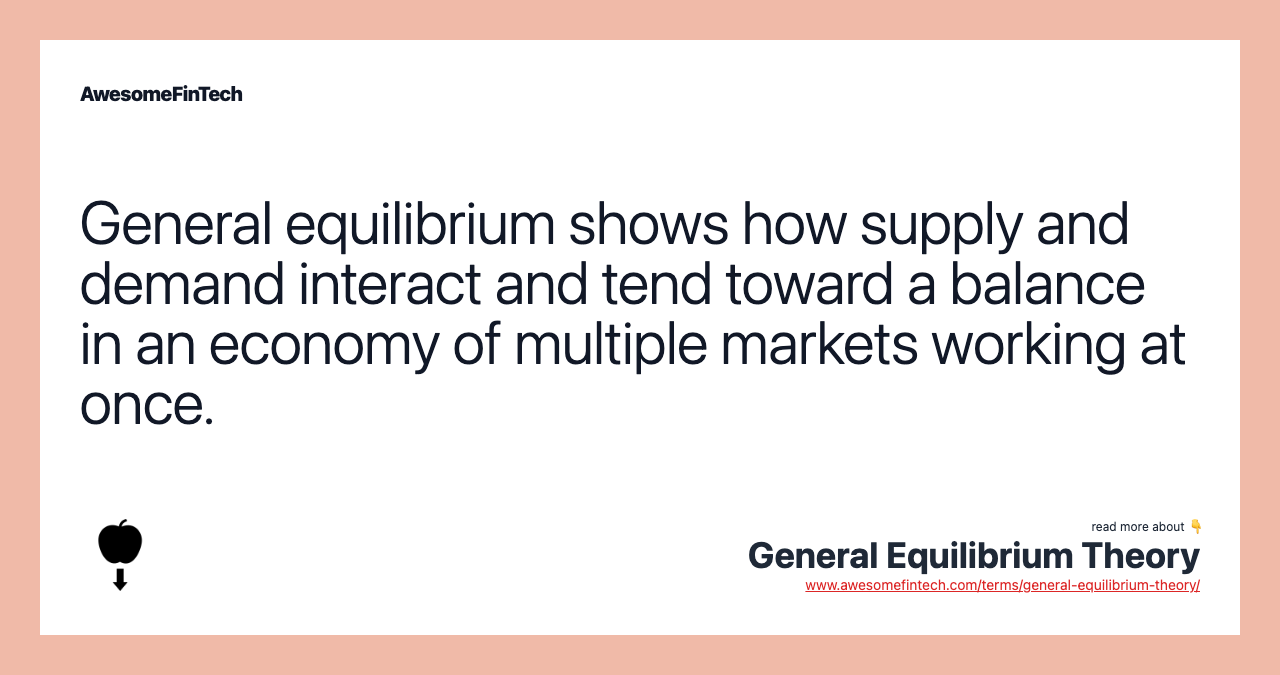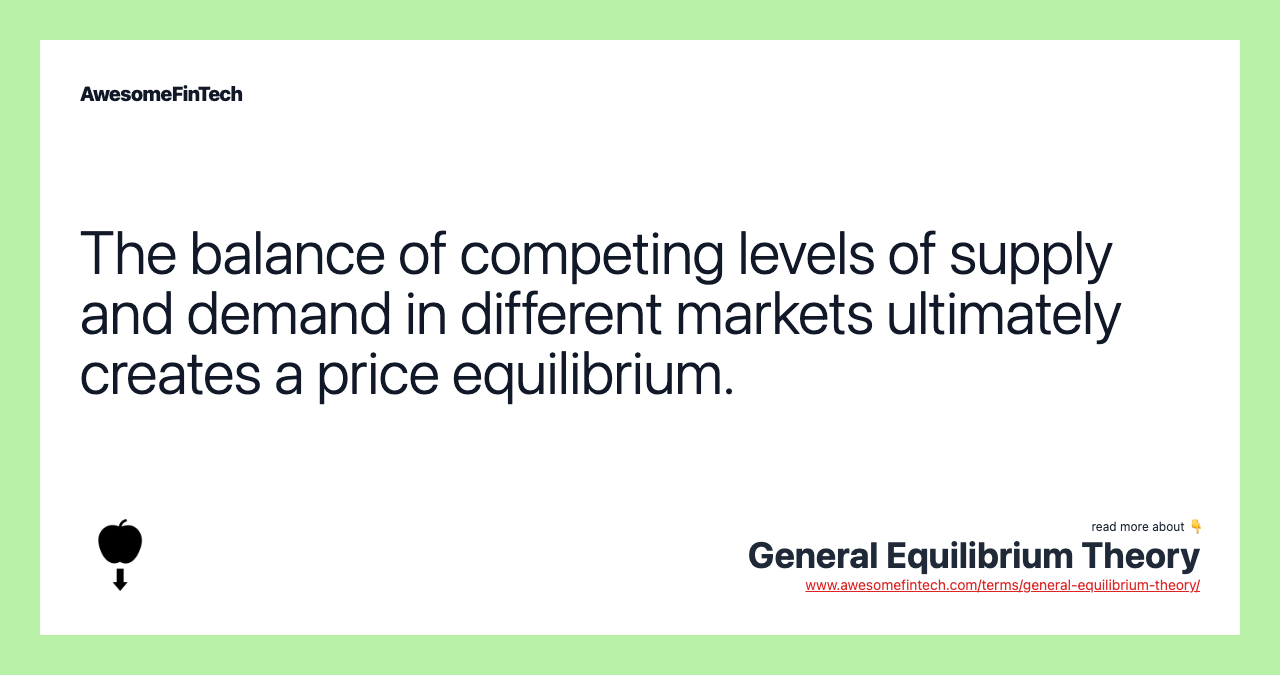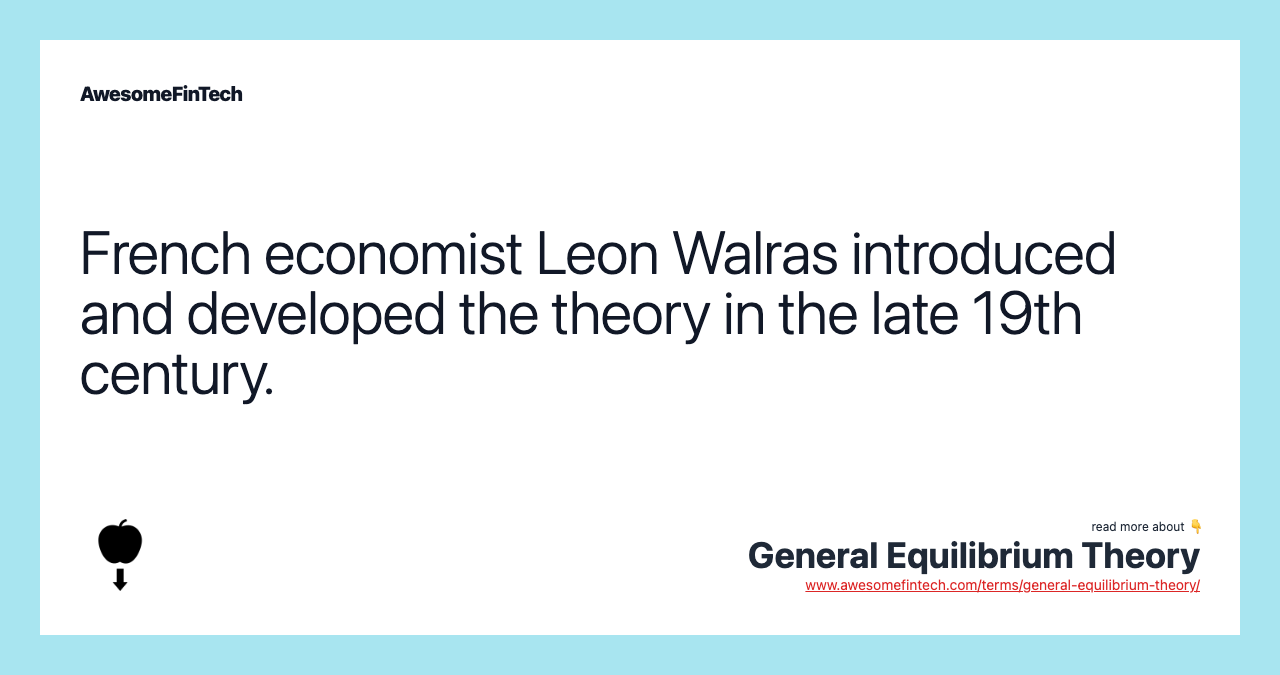General Equilibrium Theory
General equilibrium theory, or Walrasian general equilibrium, attempts to explain the functioning of the macroeconomy as a whole, rather than as collections of individual market phenomena. It was not yet shown that equilibrium could exist for all markets at the same time in aggregate. General equilibrium theory tried to show how and why all free markets tend toward equilibrium in the long run. The general equilibrium theory considers the economy as a network of interdependent markets and seeks to prove that all free markets eventually move towards general equilibrium. Those transaction prices act as signals to other producers and consumers to realign their resources and activities along more profitable lines. Walras, a talented mathematician, believed he proved that any individual market was necessarily in equilibrium if all other markets were also in equilibrium. It stands in contrast with partial equilibrium theory, or Marshallian partial equilibrium, which only analyzes specific markets or sectors.

More in Economy
What Is General Equilibrium Theory?
General equilibrium theory, or Walrasian general equilibrium, attempts to explain the functioning of the macroeconomy as a whole, rather than as collections of individual market phenomena.
The theory was first developed by the French economist Leon Walras in the late 19th century. It stands in contrast with partial equilibrium theory, or Marshallian partial equilibrium, which only analyzes specific markets or sectors.




Understanding General Equilibrium Theory
Walras developed the general equilibrium theory to solve a much-debated problem in economics. Up to that point, most economic analyses only demonstrated partial equilibrium — that is, the price at which supply equals demand and markets clear — in individual markets. It was not yet shown that equilibrium could exist for all markets at the same time in aggregate.
General equilibrium theory tried to show how and why all free markets tend toward equilibrium in the long run. The important fact was that markets didn't necessarily reach equilibrium, only that they tended toward it. As Walras wrote in 1889, “The market is like a lake agitated by the wind, where the water is incessantly seeking its level without ever reaching it.”
General equilibrium theory builds on the coordinating processes of a free market price system, first widely popularized by Adam Smith's "The Wealth of Nations" (1776). This system says traders, in a bidding process with other traders, create transactions by buying and selling goods. Those transaction prices act as signals to other producers and consumers to realign their resources and activities along more profitable lines.
Walras, a talented mathematician, believed he proved that any individual market was necessarily in equilibrium if all other markets were also in equilibrium. This became known as Walras’s Law.
The general equilibrium theory considers the economy as a network of interdependent markets and seeks to prove that all free markets eventually move towards general equilibrium.
Special Considerations
There are many assumptions, realistic and unrealistic, inside the general equilibrium framework. Each economy has a finite number of goods in a finite number of agents. Each agent has a continuous and strictly concave utility function, along with possession of a single pre-existing good (the “production good”). To increase his utility, each agent must trade his production good for other goods to be consumed.
There is a specified and limited set of market prices for the goods in this theoretical economy. Each agent relies on these prices to maximize his utility, thereby creating supply and demand for various goods. Like most equilibrium models, markets lack uncertainty, imperfect knowledge, or innovation.
Alternatives to General Equilibrium Theory
Austrian economist Ludwig von Mises developed an alternative to long-run general equilibrium with his so-called Evenly Rotating Economy (ERE). This was another imaginary construct and shared some simplifying assumptions with general equilibrium economics: no uncertainty, no monetary institutions, and no disrupting changes in resources or technology. The ERE illustrates the necessity of entrepreneurship by showing a system where none existed.
Another Austrian economist, Ludwig Lachmann, argued the economy is an ongoing, non-stable process replete with subjective knowledge and subjective expectations. He argued that equilibrium could never be mathematically proven in a general or non-partial market. Those influenced by Lachmann imagine the economy as an open-ended evolutionary process of spontaneous order.
Related terms:
Austrian School
The Austrian school is an economic school of thought that originated in Vienna during the late 19th century with the works of Carl Menger. read more
Cournot Competition
Cournot competition is an economic model in which competing firms choose a quantity to produce independently and simultaneously, named after its founder, French mathematician Augustin Cournot. read more
Depression
An economic depression is a steep and sustained drop in economic activity featuring high unemployment and negative GDP growth. read more
Equilibrium
Equilibrium is a state in which market supply and demand balance each other, and as a result, prices become stable. read more
Who Is Joseph Schumpeter? What Is He Known For?
Joseph Schumpeter is one of the 20th century's great economic thinkers, best-known for his theories on business cycles and capitalist development. read more
Ludwig von Mises
Ludwig von Mises was one of the most influential Austrian economists of the 20th century and a staunch opponent of all forms of socialism. read more
Maurice Allais
Maurice Allais was a French economist who won the 1988 Nobel Prize in Economics for his research on market equilibrium and efficiency. read more
Microeconomics , Uses, & Concepts
Microeconomics is the branch of economics that analyzes market behavior of individuals and firms in order to understand their decision-making processes. read more
Recession
A recession is a significant decline in activity across the economy lasting longer than a few months. read more
Walras's Law
Walras's law is a theory that the existence of excess supply in one market must be matched by excess demand in another market so that it balances out. read more